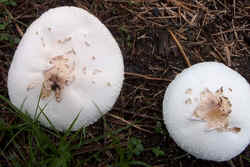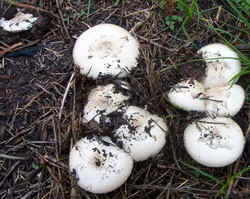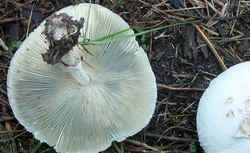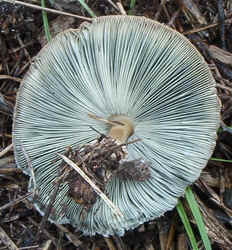 |
 |
|
Green-spored Lepiota
Scientific Name: Chlorophyllum molybdites
Family Name: Agaricaceae
Edibility: Poisonous
 |
 |
|
 |
 |
Description: Large, white mushroom with broad, buff scales over center, free white gills maturing sordid gray-green, and ring on stalk. Cap: 2-12 inches (5-30 cm) wide, doorknob-shaped, becoming flat; dry, white, with several large, pinkish-buff patches over center, breaking into many small scales on expansion. Gills: free, close, broad; white, slowly becoming sordid gray-green or darker. Stalk: 4-10 inches (10-25 cm) long, 3/4 - 1 inch (1-2.5 cm) thick, enlarging toward base; smooth, white, discoloring on handling. Veil: partial veil membranous, white, leaving persistent, double-edged, often movable, pendant ring on upper stalk. Spores: 8-13 X 6.5-8 microns; elliptical, smooth, colorless, thick-walled, with small pore at tip; dextrinoid. Spore print green. Edibility: Poisonous. Season: August-September. Habitat: Lawns, pastures, meadows; often in fairy rings. Range: Florida to California; common in Denver; reported in New York, New Jersey, and Michigan. Comments: Also known as Lepoita morgani. This very common mushroom can be a drastic sickener, causing one or two or more days of violent purging. [Lincoff, Gary H., The Audubon Society Field Guide to North American Mushrooms, Alfred A. Knopf, New York, 1981]
Edibility: Poisonous. Cap: 7-30 cm wide; convex to nearly flat with age; dry, dull; with pale brown center and scales on a white background. Flesh thick, firm, white, bruising orange and then reddish brown. Gills: Free of the stalk, closely spaced; white, becoming greenish with age. Stalk: 10-25 cm long, 1-2.5 cm thick, enlarging slightly near the base; white to creamy white, bruising reddish brown when handled; with a thick-edged, flaring, membranous, white ring. Spore Print: Pale green. Fruiting: Solitary to scattered on lawns and grasslands and along roadsides after heavy rains; late summer, fall. Range: Widely distributed but most common in southern areas. Comments: Can cause prolonged gastric distress, including severe diarrhea. [Bessette, Alan and Sundberg, Walter J., Macmillan Field Guides; Mushrooms; A quick reference guide to mushrooms of North America, Macmillan Publishing Company, New York, 1987]